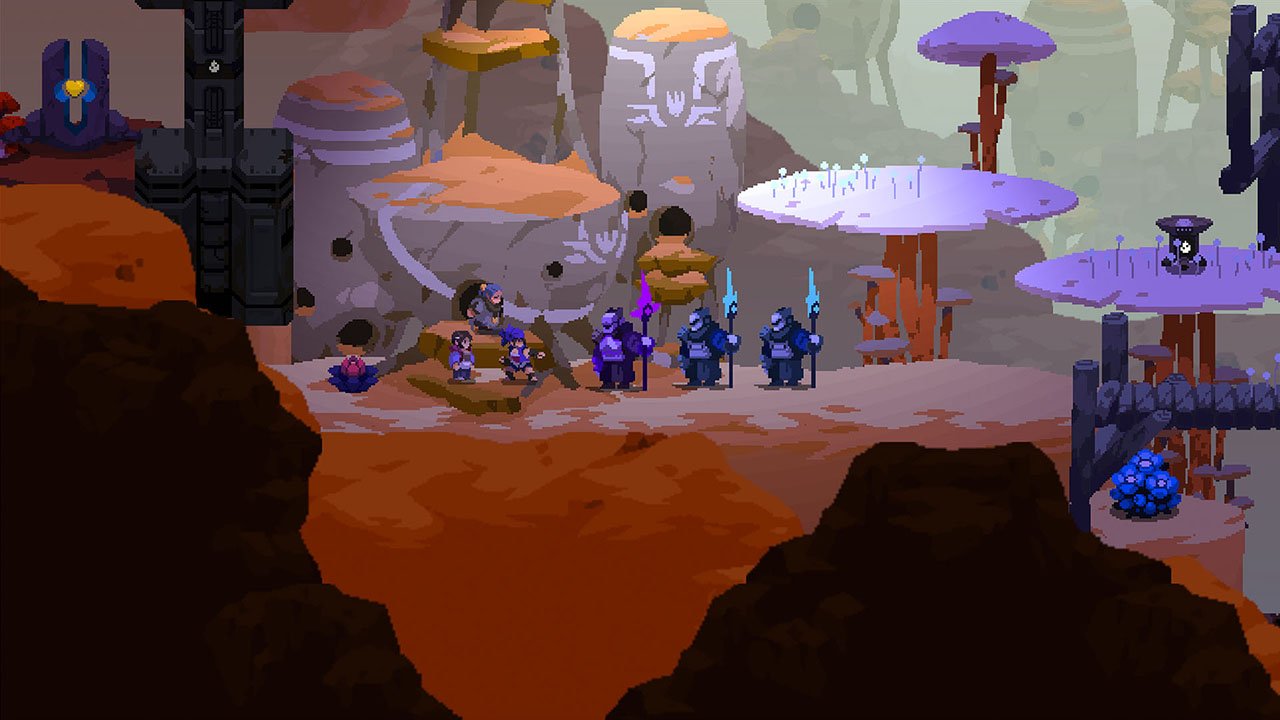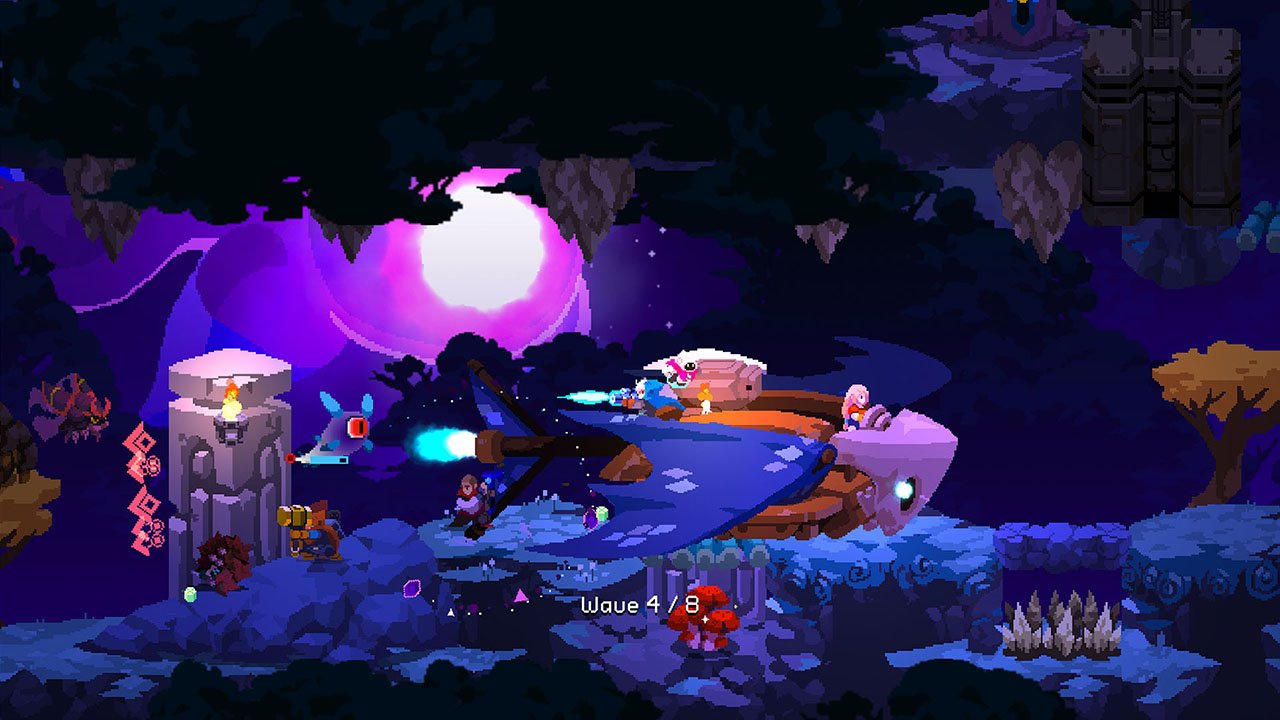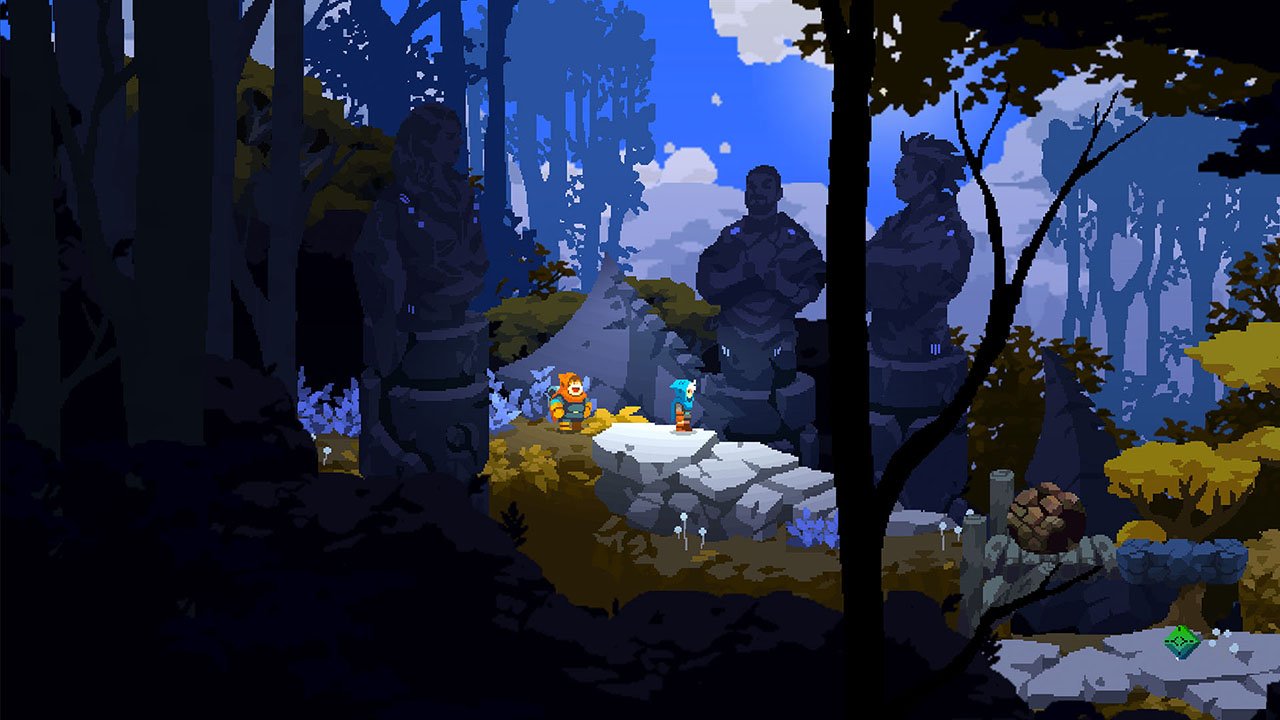Aegis Defenders Review
An enjoyable blend of platforming action and tower defense
Genre blending in games is an experiment that can produce mixed results. Attempts like these can end in colossal failure, or the creator could strike gold by finding that sweet spot, making for an intriguing and entertaining product. I’m pleased to report that Aegis Defenders, for the most part, falls under the latter category. GUTS Department’s retro-tinged indie draws from the style of the Metroidvania action-platformer, while crafting some satisfyingly deep, yet palatable tower defense mechanics that provide the bulk of the gameplay. The result is a well-rounded single and multiplayer romp, and a more memorable experience than I expected.

Aegis Defenders rides the line nicely with familiar gaming tropes, utilizing sidescrolling shooter elements that provide a smooth learning curve, and give retro gamers that warm and fuzzy nostalgic feeling. At the same time, it injects enough innovation and complexity to make for an enduring experience that can draw you in for hours at a time. This blend of old-school action platforming, along with subtle layers of depth mostly within the addictive tower defense gameplay, make for what may be one of the strongest indies of 2018.
Of course, the game isn’t exactly spotless, as there are a few cracks in the foundation. Yet they’re so minor in the scheme of things that they should be looked at more as nitpicks or matters of subjectivity. One aspect worth addressing would be the somewhat difficult control scheme of the keyboard and mouse; particularly when trying to huddle around a single keyboard with another player in the heat of battle. For this, I say simply pop in a couple of controllers and enjoy, as the game’s quality takes a pretty big leap from this change alone.
PC purists might cry foul here, but I enjoyed playing far more with an Xbox One controller than the convoluted keyboard and mouse setup. The lightning-quick aiming of a mouse isn’t exactly needed here, and the combo of using dual thumbsticks and mashing buttons meshes better with this type of game.
Have a friend or sibling tag along in your quest, and we take yet another significant leap in the level of enjoyment. Indeed, this game is all but meant to be played with two people. That’s not to say it suffers when going solo; it just doesn’t quite reach that same level of excellence.
The game is no slouch aesthetically either. The colorful pseudo-16 bit sprites actually contain some nice, fluid animation, and the environments manage to be pretty while maintaining that simplistic retro charm. The visuals act as a great compliment to the retro sidescrolling style, as does the well-crafted soundtrack. The music doesn’t stand out all that much, but it’s sufficient in providing tracks that help paint the atmosphere, ranging from soft classical melodies to more intense, adrenaline pumping tunes.

The narrative is certainly stronger than this game would let on with its cartoony aesthetic. The game stars a scavenger named Clu, and her Obi-wan Kenobi-meets-Gimli Grandfather, Bart. You find yourself in a post-apocalyptic world ruled by an oppressive empire, the Indra. This powerful force has risen to prominence largely from its exploitation of ancient resources and technologies used by the now miniscule numbers of followers of ancient gods called The Deathless. The Empire has overthrown this once peaceful civilization and now seeks the Aegis - a sort of ancient super-weapon - to further establish control and power. Caught in the middle of this chaos of conflict, you must embark on a quest to protect the Aegis. Along the way you encounter a variety of charming characters, including a robot named Kobo, and Kaiim, a monk worshiper of The Deathless. You also learn more about your role in the larger picture through light-hearted dialogue exchanges, as well as some pretty hand-drawn visual cutscenes that lay the foundation of the lore.
You play as both Clu and Bart - in addition to the aforementioned fireball-shooting monk, and a bandit armed with shurikens that you meet later along the road. Each character has something to offer and can seamlessly be swapped between on the fly. In fact, much of the game revolves around this gimmick, as there are a variety of areas that only certain characters can access. This is on account of their different abilities and color-coded gateways which only permit certain avatars to pass. An old Blizzard classic known as Lost Vikings comes to mind here, as much of Defenders’ puzzle and platforming gameplay hinges on utilizing multiple characters in tandem to progress. For instance, you might need Clu to fire her rifle at a switch protruding from a wall, which in turn opens a doorway for Bart to carry on, who then must construct blocks that act as platforms for Kaiim to proceed further.
The narrative isn’t groundbreaking, overstays its welcome a bit with drawn-out dialogue exchanges, and borders on being a tad cliché. And yet, I actually enjoyed the world-building and character development far more than I thought I would for a cartoony and pixelated tower defense platformer. I know; if only you had a nickel for every time you heard that, right?
The game’s cast of colorful characters are well rounded in both personality and abilities. As mentioned, Clu wields a rifle and works best in the role of action hero who can fend off several foes. Though she can also plant bombs, which prove equally handy in keeping most enemies at bay during the tower defense portions. Bart is a craftsman who can construct automatically-firing turrets, lay down defensive barricades, and repair items that have been damaged by pursuing forces. Kaiim’s fireballs can burn clusters of growth that reveal objects of interest, and can even draw in mineable resources with a magnetic field.

The meat of the game’s progression system lies in the items each character constructs, as you can incrementally upgrade each hero by spending earned chips which serve as currency. RP, or “Ruinhunter Points” - some of which are gained by picking preferred responses from various lines of dialogue ala Mass Effect - are also used for this purpose. You can upgrade your old items, in addition to unlocking new craftable items to aid you in the increasingly tough offensive barrages. These include resource generators, spike traps, and even fireball-spewing turrets. In addition, you can make more typical, incremental upgrades like increased health, stronger firepower, and the ability to gather a larger quantity of resources. This palette of customization fleshes things out nicely, allowing for a degree of strategy, without ever being too excessively grindy or convoluted.
While the platforming sections of the game are usually brief, the game coaxes you to explore each nook and cranny by sprinkling plenty of partially-hidden collectables, which contributes to making you more effective in battle. These come in the form of relics - which can translate to additional currency - and mineable resources, of which each character must collect their own brand to craft their respective artillery. Each platforming section also contains a few side objectives; a sort of achievement system that adds more to your pool of wealth.
The game further encourages working together and shuffling through characters by requiring a combination of resources from multiple players to craft many important items. The badass ice-spewing dragon head turret for instance calls for both Clu’s flower petals, in addition to Kaiim’s mushroom resource. This system of correspondence through color coding doesn’t just apply to resources and passageways, but to the enemies as well. Each foe comes with a color that demonstrates which hero they’re most vulnerable against, often forcing you to scramble to a different character to finish them off more quickly.
These puzzle-like attributes of collaboration, as well as mixing and matching, are used prominently, yet they’re quite subtly interwoven into the gameplay. They force the player to work out solutions and think on their feet, rather than mindlessly hop across platforms and mash buttons, as you might be led to believe from the simplistic retro vibe. The puzzle aspects can get a bit cumbersome and excessive, especially when playing solo, as frequently swapping characters and figuring out how to open that passageway can get annoying. It has a habit of slowing the pace down quite a bit and can feel like a chore at times, especially when you’ve got to juggle the tasks of 3 or 4 heroes. These sections often felt merely like a necessary burden to put up with, so I could get to the more exciting tower defense scenes. It didn’t help that there was plenty of down time in terms of the number of monsters as compared to those scenes either.

Each tower defense portion consists of a handful of waves in which a greater number of increasingly powerful foes emerge from pipes that usually flank you from multiple areas. You’re given roughly a minute to set up shop, gather resources around you, and arm yourself as best you can, until various bands of critters and monsters are unleashed. Or if you’re feeling bold, you can skip some of the downtime allotted for some bonus cash.
These parts contain situations and layouts that vary from stage to stage, ensuring you’re kept on your toes. Some maps come with mobile platforms, giant moving vehicles, or portals that allow for teleportation. The commonality though is a centralized object or area, usually smack-dab in the middle of the action, which must be protected at all costs.
For my money, the tower defense scenes - which thankfully make up most of the game - were far more fun, brimming with action and plenty of intense moments. Much like the platforming and puzzle portions, these are best played with a friend; though at least the game spares you some headache by allowing idle avatars to fire weapons at monsters on their own. Maybe this stems from my personal taste of action over puzzle gameplay, but Aegis Defenders seems to flourish most during those heated battles of fending off hordes of baddies, rather than strolling around pushing blocks onto switches and scouring for relics during the platforming segments.
Props must be given to GUTS Department for trying something a bit different though; they’ve certainly succeeded in drawing from what works within multiple genres. The game can slow down at times, though some will surely welcome this variance of pace, as it does keep things fresh. Overall, Aegis Defenders is a fun, mechanically sound ride that feels both familiar and authentic by oscillating between a few distinct gameplay styles, all of which are more-or-less executed quite well.
 Comments
Comments











